Set 7
advertisement
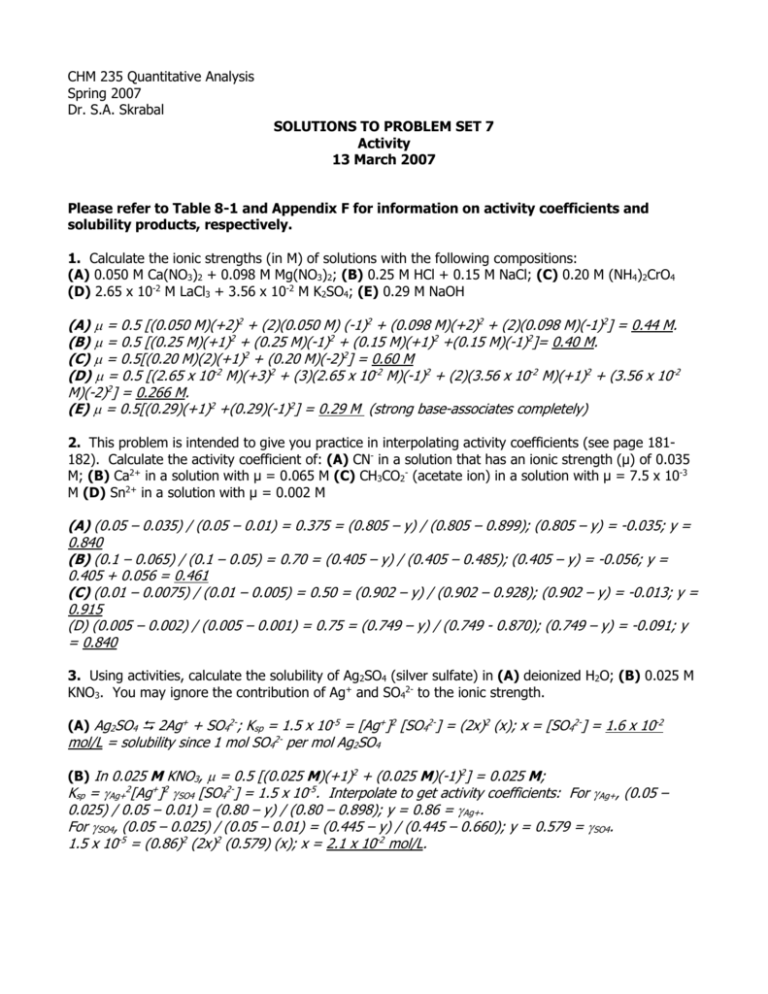
CHM 235 Quantitative Analysis Spring 2007 Dr. S.A. Skrabal SOLUTIONS TO PROBLEM SET 7 Activity 13 March 2007 Please refer to Table 8-1 and Appendix F for information on activity coefficients and solubility products, respectively. 1. Calculate the ionic strengths (in M) of solutions with the following compositions: (A) 0.050 M Ca(NO3)2 + 0.098 M Mg(NO3)2; (B) 0.25 M HCl + 0.15 M NaCl; (C) 0.20 M (NH4)2CrO4 (D) 2.65 x 10-2 M LaCl3 + 3.56 x 10-2 M K2SO4; (E) 0.29 M NaOH (A) = 0.5 [(0.050 M)(+2)2 + (2)(0.050 M) (-1)2 + (0.098 M)(+2)2 + (2)(0.098 M)(-1)2] = 0.44 M. (B) = 0.5 [(0.25 M)(+1)2 + (0.25 M)(-1)2 + (0.15 M)(+1)2 +(0.15 M)(-1)2]= 0.40 M. (C) = 0.5[(0.20 M)(2)(+1)2 + (0.20 M)(-2)2] = 0.60 M (D) = 0.5 [(2.65 x 10-2 M)(+3)2 + (3)(2.65 x 10-2 M)(-1)2 + (2)(3.56 x 10-2 M)(+1)2 + (3.56 x 10-2 M)(-2)2] = 0.266 M. (E) = 0.5[(0.29)(+1)2 +(0.29)(-1)2] = 0.29 M (strong base-associates completely) 2. This problem is intended to give you practice in interpolating activity coefficients (see page 181182). Calculate the activity coefficient of: (A) CN- in a solution that has an ionic strength (µ) of 0.035 M; (B) Ca2+ in a solution with µ = 0.065 M (C) CH3CO2- (acetate ion) in a solution with µ = 7.5 x 10-3 M (D) Sn2+ in a solution with µ = 0.002 M (A) (0.05 – 0.035) / (0.05 – 0.01) = 0.375 = (0.805 – y) / (0.805 – 0.899); (0.805 – y) = -0.035; y = 0.840 (B) (0.1 – 0.065) / (0.1 – 0.05) = 0.70 = (0.405 – y) / (0.405 – 0.485); (0.405 – y) = -0.056; y = 0.405 + 0.056 = 0.461 (C) (0.01 – 0.0075) / (0.01 – 0.005) = 0.50 = (0.902 – y) / (0.902 – 0.928); (0.902 – y) = -0.013; y = 0.915 (D) (0.005 – 0.002) / (0.005 – 0.001) = 0.75 = (0.749 – y) / (0.749 - 0.870); (0.749 – y) = -0.091; y = 0.840 3. Using activities, calculate the solubility of Ag2SO4 (silver sulfate) in (A) deionized H2O; (B) 0.025 M KNO3. You may ignore the contribution of Ag+ and SO42- to the ionic strength. (A) Ag2SO4 2Ag+ + SO42-; Ksp = 1.5 x 10-5 = [Ag+]2 [SO42-] = (2x)2 (x); x = [SO42-] = 1.6 x 10-2 mol/L = solubility since 1 mol SO42- per mol Ag2SO4 (B) In 0.025 M KNO3, = 0.5 [(0.025 M)(+1)2 + (0.025 M)(-1)2] = 0.025 M; Ksp = Ag+2[Ag+]2 SO4 [SO42-] = 1.5 x 10-5. Interpolate to get activity coefficients: For Ag+, (0.05 – 0.025) / 0.05 – 0.01) = (0.80 – y) / (0.80 – 0.898); y = 0.86 = Ag+. For SO4, (0.05 – 0.025) / (0.05 – 0.01) = (0.445 – y) / (0.445 – 0.660); y = 0.579 = SO4. 1.5 x 10-5 = (0.86)2 (2x)2 (0.579) (x); x = 2.1 x 10-2 mol/L. 4. Using activities, calculate the solubility of amorphous Zn(OH)2 in 0.020 M K2SO4. Zn(OH)2(s) Zn2+(aq) + 2OH-(aq) Ksp = Zn2+[Zn2+] OH- [OH-]2 = 3.0 x 10-16 In 0.020 M K2SO4, = 0.5 [(0.020 M)(2)(+1)2 + (0.020 M)(-2)2] = 0.060 M; Interpolate to get activity coefficients: For Zn2+, (0.10 – 0.060) / 0.10 – 0.05) = (0.405 – y) / (0.405 – 0.485); y = 0.469 = Zn2+. For OH-, (0.10 – 0.060 / (0.10 – 0.050) = (0.76 – y) / (0.76 – 0.81); y = 0.80 = OH3.0 x 10-16 = (0.469)(x) (0.80)2 (2x)2; x = 6.3 x 10-6 mol/L. Note that solubility in deionized water would be 4.2 x 10-6 M. 5. Using activities, calculate the solubility of PbI2 (lead iodide) in 0.095 M KNO3. You may ignore the contribution of Pb2+ and I- to the ionic strength. PbI2 Pb2+ + 2IKsp = Pb2+ [Pb2+] I-2 [I-]2 = 7.9 x 10-9. Ionic strength of solution, = [(0.095 M)(+1)2 + (0.095 M)(-1)2] = 0.095 M. Interpolation of activity coefficients: For Pb2+, (0.1 – 0.095) / (0.1 – 0.05) = (0.37 – y) / (0.37 – 0.455); y = Pb2+ = 0.38; for I-, (0.1 – 0.095) / (0.1 – 0.05) = (0.755 – y) / (0.755 – 0.805); y = I- = 0.760. 7.9 x 10-9 = (0.38) (x) (0.760)2 (2x)2; x = solubility = 2.1 x 10-3 mol/L. Note that solubility in deionized water would be 1.3 x 10-3 mol/L. 6. Using activities, calculate the solubility of Ag4Fe(CN)6 (silver ferrocyanide) in 0.25 M NaCl. The dissolution reaction is: Ag4Fe(CN)6 (s) 4 Ag+ (aq) + Fe(CN)64- (aq). You may ignore the contribution of Ag+ and Fe(CN)64- to the ionic strength. Ksp = (Ag+1)4 [Ag+]4 Fe(CN)64- [Fe(CN)64-] = 8.5 x 10-45 Ionic strength of solution, = [(0.25 M)(+1)2 + (0.25 M)(-1)2] = 0.25 M. The clever student must notice that to obtain the activity coefficients, one must use the extended Debye-Hückel equation (eqn. 8-6 in text) since Table 8-1 doesn’t go beyond µ = 0.1 M. The size parameter for each ion can be obtained from Table 8-1. Ag+ = 0.659 Fe(CN)64- = 0.00573 8.5 x 10-45 = (0.659)4 (4x)4 (0.00573) (x), where x = [Fe(CN)64-] and 4x = [Ag+] so x = solubility = 2.0 x 10-9 M. Note that solubility in deionized water would be 5.1 x 10-10 M
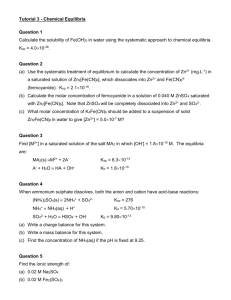
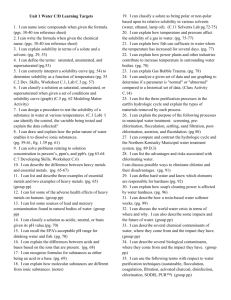
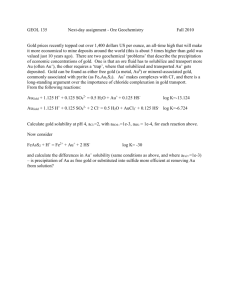

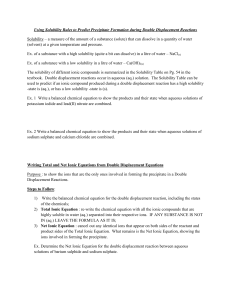
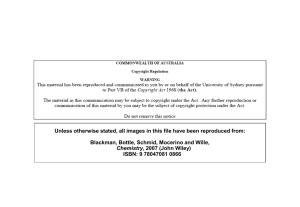



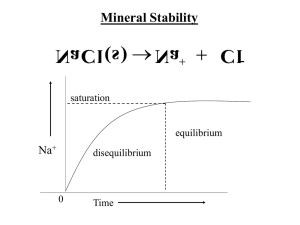
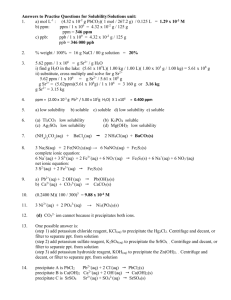
![K sp = [Pb 2+ (aq)][Cl](http://s2.studylib.net/store/data/005788724_1-fd79e2539544b4374a3f7aa03b8a844b-300x300.png)